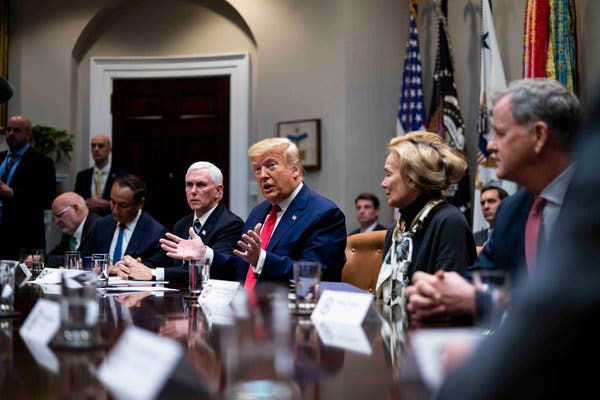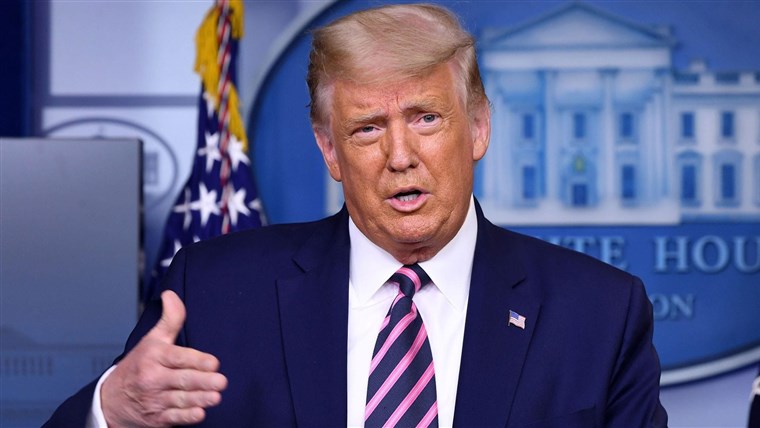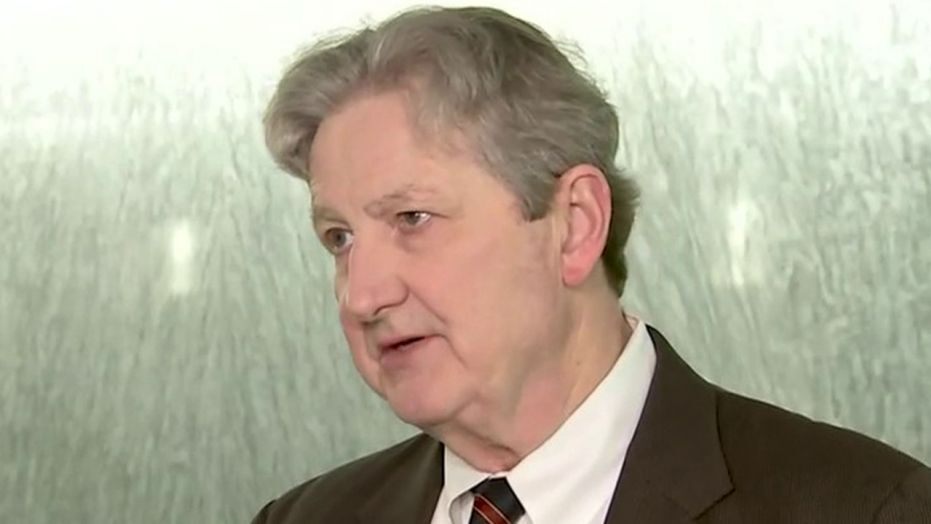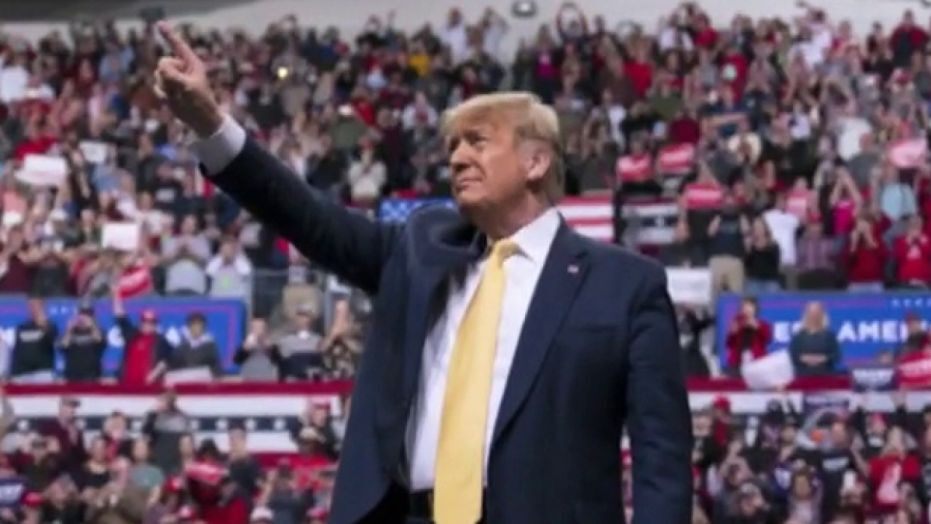Advertisement
The president said a “very detrimental” decision adopted under his predecessor initially hampered the ability to enact widespread testing for the virus.

WASHINGTON — President Trump sought on Wednesday to deflect criticism of his administration’s response to the coronavirus onto his predecessor, complaining that a federal agency decision under President Barack Obama had made it harder to quickly enact widespread testing for the virus.
“The Obama administration made a decision on testing that turned out to be very detrimental to what we’re doing, and we undid that decision a few days ago so that the testing can take place in a much more accurate and rapid fashion,” Mr. Trump said. “That was a decision we disagreed with. I don’t think we would have made it, but for some reason it was made. But we’ve undone that decision.”
It was not entirely clear what he was referring to. Health experts and veterans of the government during Mr. Obama’s presidency said they were unaware of any policy or rule changes during the last administration that would have affected the way the Food and Drug Administration approved tests during the current crisis. Moreover, if there were, Mr. Trump did not explain why his administration did not change the rules during its first three years in office.
The coronavirus outbreak is now into its third month. Testing restrictions were lifted over the weekend.
Mr. Trump appeared intent on focusing attention on the Obama administration at a time when his own handling of the outbreak has come under intense criticism. He made a point of using the former president’s name in comments to reporters during a White House meeting with airline executives, called to discuss the economic effect of the virus.
Among other things, critics have pointed to the dismantling of a White House effort set up by Mr. Obama to respond to global health emergencies. The officials involved have left and not been replaced over the past two years, a point made by Obama administration veterans in recent days.
No coronavirus issue has attracted as much attention as testing, which even now lags behind other countries dealing with the virus. Local health agencies have complained that a lack of coronavirus tests has hindered their abilities to identify patients, and tight restrictions imposed by the Centers for Disease Control and Prevention on who could be tested have meant that some infected patients waited days before a diagnosis. The last restrictions were lifted Tuesday.
“We want to make sure the American people can go to their doctor, can go to the local MedCheck or CVS and obtain access to coronavirus” tests, Vice President Mike Pence, who is leading the administration’s response to the virus, said Wednesday during a White House meeting with laboratory executives.
In raising the testing issue, the president appeared to refer to a practice that limited the ability of laboratories run by states, universities and private companies to conduct medical screenings not approved by the Food and Drug Administration.
On Saturday, the agency’s commissioner, Stephen M. Hahn, allowed those labs to use tests that they had independently developed. The labs had to submit evidence of the tests’ accuracy before the F.D.A. completes its review. Dozens of labs have now applied for emergency approval under the decision.
Dr. Robert Redfield, the C.D.C. director, said the change was quickly making tests more available. “It’s really very important,” he said at the White House event with Mr. Trump. “It’s what’s changed the availability of testing overnight.”
Michelle Forman, a spokeswoman for the Association of Public Health Laboratories, whose members had complained that the Food and Drug Administration took too long to approve their tests, said there were some discussions during the Obama administration about whether to tighten restrictions on laboratories that developed their own tests, but “nothing was ever put into place.”
She said the association, which represents state and local government labs, was not aware of any Obama-era rules that changed how the labs were regulated or how applications in a public health crisis were reviewed.
Dr. Luciana Borio, who oversaw public health preparedness for the National Security Council in Mr. Trump’s White House and was previously the acting chief scientist at the Food and Drug Administration under Mr. Obama, also said she was unaware of any such rule changes during the last administration.
The F.D.A. had long held that in an emergency, it wanted to ensure that labs develop tests that were accurate, she said. But “it shouldn’t be more onerous, in theory, because these are very speedy and streamlined,” she said, adding that such approvals can happen within 24 hours.
The Project Bioshield Act of 2004 enabled the Food and Drug Administration to require labs to get agency permission to perform certain tests during a public health emergency. In 2009, the Obama administration used that authority for the first time for the H1N1 virus, according to Dr. Joshua Sharfstein, who was then the agency’s principal deputy commissioner.
Separately, during the Obama administration, the Food and Drug Administration first started proposing the regulation of lab-developed tests, but that was to apply outside of emergency situations. It was never finalized. It would have required all lab-developed tests to get premarket review.
Instead, the agency issued a series of “guidances” regarding such tests.
The Food and Drug Administration took the position that during a public health emergency, nongovernment labs should come to the it before doing tests. But at any time, the agency was prepared to suspend that practice, as it did on Saturday.
Mr. Obama did not immediately respond to the president’s remarks on Wednesday, but he separately posted a message on Twitter urging Americans to follow advice from the C.D.C.
“Protect yourself and your community from coronavirus with common sense precautions: wash your hands, stay home when sick and listen to the @CDCgov and local health authorities,” he wrote. “Save the masks for health care workers. Let’s stay calm, listen to the experts, and follow the science.”
Mr. Trump, joining the meeting with airline executives, which had been set to be led by Mr. Pence, sought to reassure Americans that the outbreak was under control and portrayed the cancellation of hundreds of thousands of international flights to affected countries like China as a boon for domestic travel.
“A lot of people are doing a lot of domestic business now, I can tell you,” the president said. “They’re staying in this country. They feel safe because we have a — if you look at a percentage, we have a very, very small percentage” of infections.
Asked if he considered it safe to fly, Mr. Trump pointed at the executives around his table: “Where these people are flying, it’s safe to fly.”
But the airline executives made clear that they were struggling to convince passengers of that. “Right now, the fear is almost worse than the virus,” Nicholas E. Calio, the president and chief executive of Airlines for America, the trade association for leading passenger and cargo airlines, told Mr. Trump, gently pressing him to do more to reassure the traveling public.
The president did not directly offer any additional help. “Yeah, no, we’re doing a good job,” he responded.
But the famously germ-phobic Mr. Trump said he was doing his part by following medical advice on how to avoid becoming infected. “I haven’t touched my face in weeks,” he said. “Been weeks. I miss it.”
Katie Thomas contributed reporting from Chicago.


